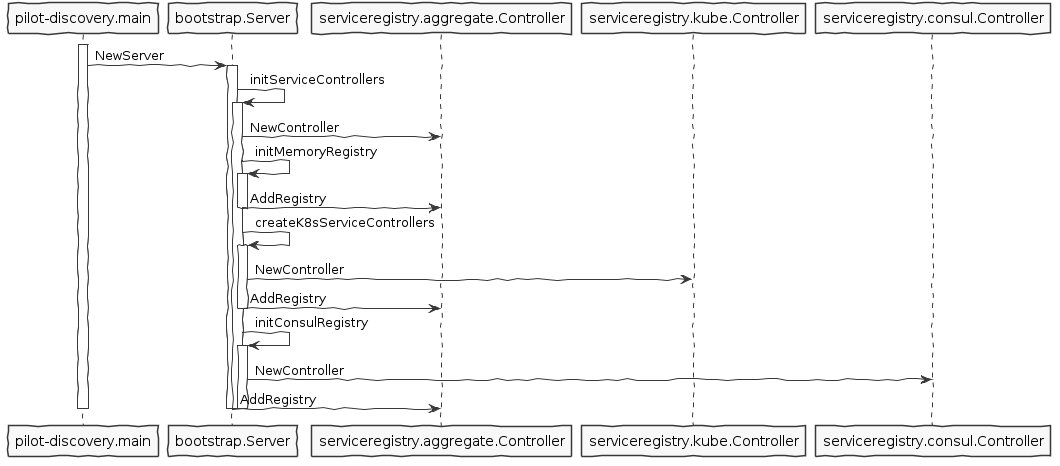Istio服务注册插件机制
在Istio架构中,Pilot组件负责维护网格中的标准服务模型,该标准服务模型独立于各种底层平台,Pilot通过适配器和各底层平台对接,以使用底层平台中的服务数据填充此标准模型。
例如Pilot中的Kubernetes适配器通过Kubernetes API Server到kubernetes中的Service以及对应的POD实例,将该数据被翻译为标准模型提供给Pilot使用。通过适配器模式,Pilot还可以从Cloud Foundry, Consul中获取服务信息,也可以开发适配器将其他提供服务发现的组件集成到Pilot中。

本文将从代码出发,对Pilot的服务注册机制进行分析。
备注: 本文分析的代码对应Istio commit 58186e1dc3392de842bc2b2c788f993878e0f123
服务注册相关的对象
首先我们来了解一下Pilot中关于服务注册的一些基本概念和相关数据结构。
Istio源码中,和服务注册相关的对象如下面的UML类图所示。

Service
源码文件:pilot/pkg/model/service.go
Service用于表示Istio服务网格中的一个服务(例如 catalog.mystore.com:8080)。每一个服务有一个全限定域名(FQDN)和一个或者多个接收客户端请求的监听端口。
一个服务可以有一个可选的 负载均衡器/虚拟IP,DNS解析会对应到该虚拟IP(负载均衡器的IP)上。 一般来说,不管后端的服务实例如何变化,VIP是不会变化的,Istio会维护VIP和后端实例真实IP的对应关系。
例如在Kubernetes中,服务 foo 的FQDN为foo.default.svc.cluster.local, 拥有一个虚拟IP 10.0.1.1,在端口80和8080上监听客户端请求。
type Service struct {
// Hostn/服务器名
Hostname Hostname `json:"hostname"`
// 虚拟IP / 负载均衡器 IP
Address string `json:"address,omitempty"`
// 如果服务部署在多个集群中,ClusterVIPs会保存不同集群中该服务对应的VIP
ClusterVIPs map[string]string `json:"cluster-vips,omitempty"`
// 服务端口列表
Ports PortList `json:"ports,omitempty"`
// 运行该服务的服务账号
ServiceAccounts []string `json:"serviceaccounts,omitempty"`
// 该服务是否为一个 “外部服务”, 采用 ServiceEntry 定义的服务该标志为true
MeshExternal bool
// 服务解析规则: 包括
// ClientSideLB: 由Envoy代理根据其本地的LB pool进行请求路由
// DNSLB: 查询DNS服务器得到IP地址,并将请求发到该IP
// Passthrough: 将请求发转发到其原始目的地
Resolution Resolution
// 服务创建时间
CreationTime time.Time `json:"creationTime,omitempty"`
// 服务的一些附加属性
Attributes ServiceAttributes
}
ServiceInstance
源码文件:pilot/pkg/model/service.go
SercieInstance中存放了服务实例相关的信息,一个Service可以对应到一到多个Service Instance,Istio在收到客户端请求时,会根据该Service配置的LB策略和路由规则从可用的Service Instance中选择一个来提供服务。
type ServiceInstance struct {
// Endpoint中包括服务实例的IP:Port,UID等
Endpoint NetworkEndpoint `json:"endpoint,omitempty"`
// 对应的服务
Service *Service `json:"service,omitempty"`
// 该实例上的标签,例如版本号
Labels Labels `json:"labels,omitempty"`
// 运行该服务的服务账号
ServiceAccount string `json:"serviceaccount,omitempty"`
}
Registry
源码文件: pilot/pkg/serviceregistry/aggregate/controller.go
Registry代表一个通过适配器插入到Pilot中的服务注册表,即Kubernetes,Cloud Foundry 或者 Consul 等具体后端的服务部署/服务注册发现平台。
Registry结构体中包含了Service Registry相关的一些接口和属性。
type Registry struct {
// 注册表的类型,例如Kubernetes, Consul, 等等。
Name serviceregistry.ServiceRegistry
// 某些类型的服务注册表支持多集群,例如Kubernetes,在这种情况下需要用CluterID来区分同一类型下不同集群的服务注册表
ClusterID string
// 控制器,负责向外发送该Registry相关的Service变化消息
model.Controller
// 服务发现接口,用于获取注册表中的服务信息
model.ServiceDiscovery
}
Istio支持以下几种服务注册表类型:
源码文件: pilot/pkg/serviceregistry/platform.go
// ServiceRegistry defines underlying platform supporting service registry
type ServiceRegistry string
const (
// MockRegistry,用于测试的服务注册表,包含两个硬编码的test services
MockRegistry ServiceRegistry = "Mock"
// ConfigRegistry,可以从Configstore中获取定义的service registry,加入到Istio的服务列表中
KubernetesRegistry ServiceRegistry = "Kubernetes"
// 从Consul获取服务数据的服务注册表
ConsulRegistry ServiceRegistry = "Consul"
// 采用“Mesh Configuration Protocol”的服务注册表
MCPRegistry ServiceRegistry = "MCP"
)
其中支持最完善的就是Kubernetes了,我在项目中使用了Consul,填坑的经验证明对Consul的支持只是原型验证级别的,要在产品中使用的话还需要对其进行较多的改进和优化。
注册表中最后一个类型是 MCP,MCP 是 “Mesh Configuration Protocol" 的缩写。 Istio 使用了 MCP 实现了一个服务注册和路由配置的标准接口,MCP Server可以从Kubernetes,Cloud Foundry, Consul等获取服务信息和配置数据,并将这些信息通过MCP提供给 MCP Client,即Pilot,通过这种方式,将目前特定平台的相关的代码从Pilot中剥离到独立的MCP服务器中,使Pilot的架构和代码更为清晰。MCP将逐渐替换目前的各种Adapter。更多关于MCP的内容参见:
- https://docs.google.com/document/d/1o2-V4TLJ8fJACXdlsnxKxDv2Luryo48bAhR8ShxE5-k/edit
- https://docs.google.com/document/d/1S5ygkxR1alNI8cWGG4O4iV8zp8dA6Oc23zQCvFxr83U/edit
Controller
源码文件: pilot/pkg/model/controller.go
Controller抽象了一个Service Registry变化通知的接口,该接口会将Service及Service Instance的增加,删除,变化等消息通知给ServiceHandler。
调用Controller的Run方法后,Controller会一直执行,将监控Service Registry的变化,并将通知到注册到Controller中的ServiceHandler中。
type Controller interface {
// 添加一个Service Handler,服务的变化会通知到该Handler
AppendServiceHandler(f func(*Service, Event)) error
// 添加一个Service Instance Handler, 服务实例的变化会通知到该Handler
AppendInstanceHandler(f func(*ServiceInstance, Event)) error
// 启动Controller的主循环,对Service Catalog的变化进行分发
Run(stop <-chan struct{})
}
ServiceDiscovery
源码文件: pilot/pkg/model/service.go
ServiceDiscovery抽象了一个服务发现的接口,可以通过该接口获取到Service Registry中的Service和Service Instance。
type ServiceDiscovery interface {
// 列出该Service Registry中的所有服务
Services() ([]*Service, error)
// 根据主机名查询服务
// 该接口已废弃
GetService(hostname Hostname) (*Service, error)
// 根据主机名,服务端点和标签查询服务实例
InstancesByPort(hostname Hostname, servicePort int, labels LabelsCollection) ([]*ServiceInstance, error)
// 查询边车代理所在节点上的服务实例
GetProxyServiceInstances(*Proxy) ([]*ServiceInstance, error)
// 获取边车代理所在的Region,Zone和SubZone
GetProxyLocality(*Proxy) string
// 管理端口,Istio生成的配置会将管理端口的流量排除,不进行路由处理
ManagementPorts(addr string) PortList
// 列出用于监控检查的探针
WorkloadHealthCheckInfo(addr string) ProbeList
}
Service Registry初始化流程
Service Registry初始化的主要逻辑在Pilot-discovery程序的主函数中,对应的源码为:pilot/cmd/pilot-discovery/main.go和pilot/pkg/bootstrap/server.go。
在pilot/pkg/bootstrap/server.go中,初始化了各种Service Registry,其流程如下图所示:
(备注: MCP Registry尚在开发过程中)

Pilot将各个Service Registry(Memory, Kube, Consul)保存在serviceregistry.aggreagete.Controller中进行统一管理,Pilot会从所有类型的Registry中查询服务和服务实例,并监控所有Registry的数据变化,当Registry数据变化后,Pilot会清空其内部的缓存并通过ADS接口向Envoy推送更新。

备注:上图中的controller实际上是Service Registry,aggregate controller和具体的各个类型的controller同时实现了Registry要求的controller和discovery interface。
Registry的业务逻辑在Kube Controller和Consul controller中,我们主要使用了Consul Controller, 其主要方法如下:
源码文件: pilot/pkg/serviceregistry/consul/controller.go
▼+Controller : struct
[fields]
-client : *api.Client
-monitor : Monitor
[methods]
+AppendInstanceHandler(f func(*model.ServiceInstance, model.Event)) : error
+AppendServiceHandler(f func(*model.Service, model.Event)) : error
+GetIstioServiceAccounts(hostname model.Hostname, ports []int) : []string
+GetProxyServiceInstances(node *model.Proxy) : []*model.ServiceInstance, error
+GetService(hostname model.Hostname) : *model.Service, error
+InstancesByPort(hostname model.Hostname, port int, labels model.LabelsCollection) : []*model.ServiceInstance, error
+ManagementPorts(addr string) : model.PortList
+Run(stop chan )
+Services() : []*model.Service, error
+WorkloadHealthCheckInfo(addr string) : model.ProbeList
-getCatalogService(name string, q *api.QueryOptions) : []*api.CatalogService, error
-getServices() : map[string][]string, error
[functions]
+NewController(addr string, interval time.Duration) : *Controller, error
可以看到Consul Controller对象同时实现了Registry要求的Controller和ServiceDiscovery接口,可以提供Registry的变化通知和服务查询相关功能。
目前Consul Controller的实现比较简单粗暴,定时通过Consul的Rest API获取服务数据并和上一次的查询结果进行对比,如果数据发生了变化则通知Pilot discovery进行更新。该方式发起了大量对Consul Server的HTTP请求,会导致Consul Server CPU占用率高和大量TCP Socket处于TIME_WAIT状态,不能直接在产品环境下使用。
源码文件: pilot/pkg/serviceregistry/consul/monitor.go
//定时轮询Consul Server Rest接口,以获取服务数据变化
func (m *consulMonitor) run(stop <-chan struct{}) {
ticker := time.NewTicker(m.period)
for {
select {
case <-stop:
ticker.Stop()
return
case <-ticker.C:
m.updateServiceRecord()
m.updateInstanceRecord()
}
}
}
//比较这一次和上一次的服务数据,如有变化则回调ServiceHandler进行通知
func (m *consulMonitor) updateServiceRecord() {
svcs, _, err := m.discovery.Catalog().Services(nil)
if err != nil {
log.Warnf("Could not fetch services: %v", err)
return
}
newRecord := consulServices(svcs)
if !reflect.DeepEqual(newRecord, m.serviceCachedRecord) {
// This is only a work-around solution currently
// Since Handler functions generally act as a refresher
// regardless of the input, thus passing in meaningless
// input should make functionalities work
//TODO
obj := []*api.CatalogService{}
var event model.Event
for _, f := range m.serviceHandlers {
go func(handler ServiceHandler) {
if err := handler(obj, event); err != nil {
log.Warnf("Error executing service handler function: %v", err)
}
}(f)
}
m.serviceCachedRecord = newRecord
}
}
我们在Consul Registry中增加了缓存,并降低了Pilot轮询Consul server的频率,以减少Pilot频繁调用给Consul server带来的大量压力,下一步打算采用Consul watch来代替轮询,优化Consul Registry的服务变化通知机制。